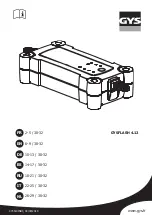
P-FBC100/EUR (P-FBC110/EUR) Li-Po Charger Manual
This LiPo-charger is for use with Futaba T14SG, FX-22 and FX-32 when fitted with the supplied
Li-Po batteries only - it is not to be used for any other transmitter or Li-Po battery, as these may
lack the internal balancing circuitry required for safe charging.
Please note that this charger is different from the type described in the radio manual. Please
charge the transmitter using the instructions in this manual, not those in the radio manual
Please read this manual carefully before using the charger and follow the instructions.
Technical Parameters:
Input: AC 110-240V 50/60Hz
Rated output voltage/current: 8.4V/0.5A (4.2VA. max)
Practical battery specification: 2S Li-Po (2800/3400mAh)
Battery Charging Times:
The charge time from flat for the 2800mAh battery of the 14SG is around 5 ½ hours, whilst the
charge time for the 3400mAh battery of the FX22/32 is around 7 hours.
Unplug the AC power and charge connector when the charge light turns green.
Instructions:
Push the charger output plug carefully into the transmitter charging socket, then insert the AC
mains plug of the charger into the AC power socket. Switch the AC power on, and the charge light
on the charger will illuminate red, confirming that the battery is being charged.
When the battery is fully charged the charge light on the charger will change to green, this
confirms that the charge cycle has completed.
When charging is completed, pull out the mains input plug first and then the output jack plug.
Charge Indicator Light Colours:
Red:
Normal charging is taking place.
Green:
Charging completed (or not connected to a battery).
Off:
No AC input power.
Safety Precautions:
• Please check the charger’s AC input voltage range matches your local mains AC
voltage before use.
• This charger is only suitable for indoor use.
• This charger must not be covered when in use, and should be positioned
well away from any heat source such as a radiator, heater etc to avoiding
overheating and the risk of a fire.
• This charger should not be used by children unless supervised by an adult.






















